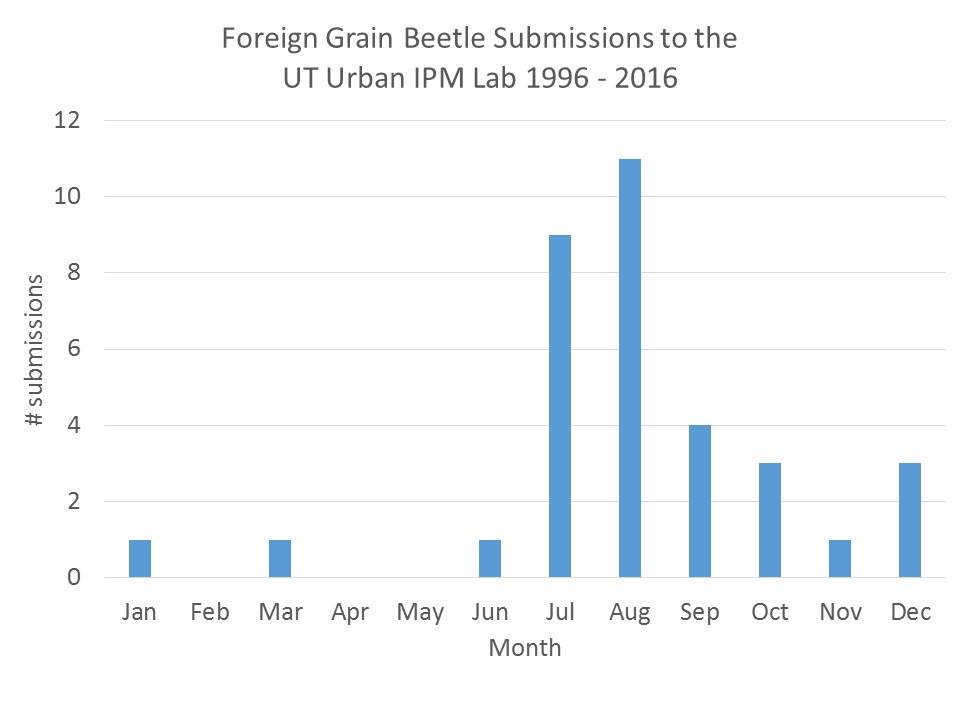Karen Vail, University of Tennessee Entomology and Plant Pathology Department, Knoxville
In 1996, my first year as an assistant professor and Extension urban entomologist at the University of Tennessee, I had received a small (2–3 mm), flat, reddish-brown beetle from a home and I could not identify it. I had worked the keys for stored product pests and wasn’t satisfied that the species in front of me matched the image from the key. What should I tell the client? Fortunately, the answer was revealed to me at a local pest control association meeting during discussions with one of the more experienced pest management professionals. He asked me if I had noticed the foreign grain beetle adults emerging. I had not noticed them; I hadn’t even heard of a foreign grain beetle. This species is not included in theHandbook of Pest Control nor the NPMA Field Guide to Structural Pests. So, I began my quest for information on foreign grain beetles.
The foreign grain beetle, Ahasverus advena (Waltl) (Coleoptera: Silvanidae), is a minor, secondary grain pest that feeds on molds or fungi growing on stored grains (or occasionally on the stored grains themselves). It is usually associated with high moisture and grains in poor condition. As an urban entomologist, I’m most likely to receive submissions from residents or pest management professionals when this insect feeds on molds or fungi growing in structures.
The foreign grain beetle is identified by the laterally directed rounded lobes on the anterior pronotum’s corners and the three-segmented antennal club (Figure 1). These characteristics should help distinguish this beetle from other silvanids with obvious teeth on the lateral borders of the pronotum (sawtoothed grain beetle or merchant grain beetle) and other fungus-feeding, small flat beetles such as latridiids or cryptophagids.
.jpg)
Figure 1. The foreign grain beetle is 1.9 – 2.5 mm long and feeds on molds and fungi. Note the laterally directed rounded lobes on the corners of the anterior pronotum. Credit: Emille Bess, USDA APHIS PPQ, Bugwood.org
In homes, beetles are usually present in the immediate years following construction. Females will oviposit on moist lumber covered with mold or decay fungi present during building. Larvae feed on the fungi. Beetle development is insignificant below 65% relative humidity or when the temperature is less than 59 degrees F (15 degrees C); most submissions to our lab occur in summer (Figure 2). Adult beetles from wall voids, or possibly fields, become visible inside the structure when they are attracted to interior lights. Management tactics comprise reducing moisture which may include fixing leaks, installing dehumidifiers, and increasing air flow through actions such as installing wall vents. Attempting to speed the drying process may prove futile and residents may wait several years for the structure to dry sufficiently to reduce the fungal/mold growth that supports the beetles. Insecticides (dusts, foams, aerosols) may be directed into the infested voids but the beetles may still emerge and die in locations visible to the resident.

Figure 2 . Cumulative number of foreign grain beetles submitted to the University of Tennessee Urban IPM Lab from 1996 to 2016.
Sources:
El Damir, M. 2012. [Pest Profile] Follow the Moisture. PCT https://www.pctonline.com/article/pct0612-foreign-grain-beetle-management/
Gorham, J. 1991. Insect and Mite Pests in Food: An. Illustrated Key Volume 1. U.S. Department of Agriculture, Handbook Number 655, 767 pp. https://www.ars.usda.gov/ARSUserFiles/2863/pdfdocuments/Gorham%201991%20V1.pdf
Mallis, Arnold. Handbook of Pest Control. 10th Edition. 2011. Mallis HandbookCo., Cleveland, OH.
Potter, M. 2016. Foreign grain beetles. University of Kentucky, College of Agriculture, Cooperative Extension Service. https://entomology.ca.uky.edu/files/efpdf3/ef610.pdf
Smith, E. H. and R.C. Whitman. 2007. NPMA Field Guide to Structural Pests, 2nd ed. NPMA, Fairfax, VA.

